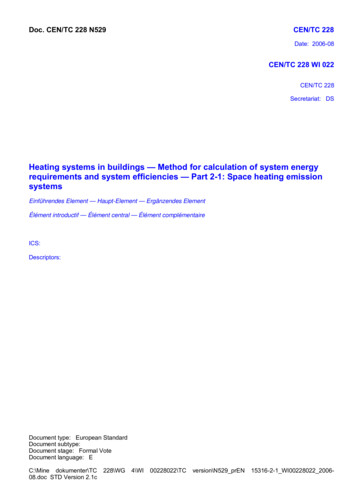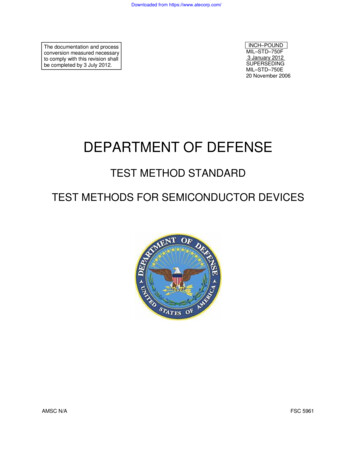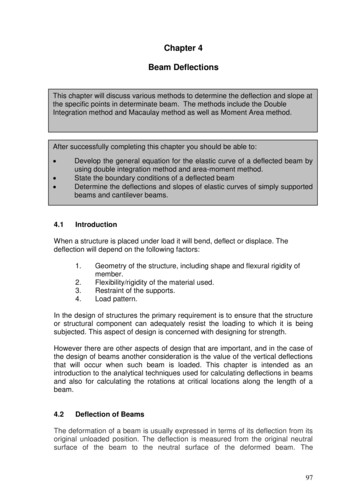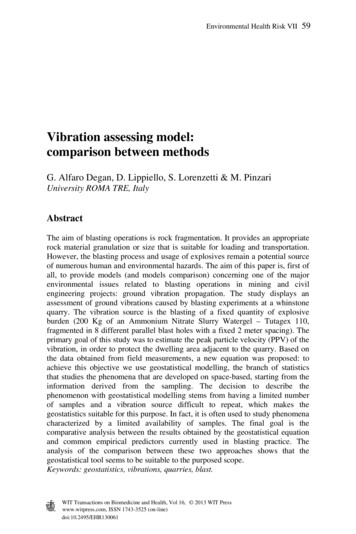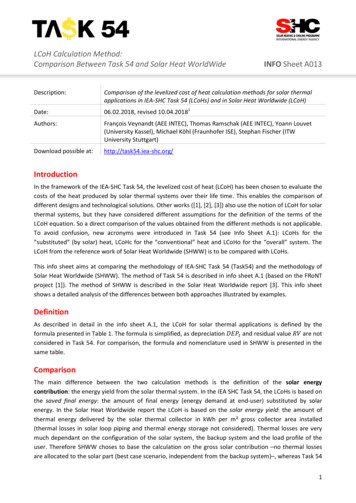
Transcription
LCoH Calculation Method:Comparison Between Task 54 and Solar Heat WorldWideINFO Sheet A013Description:Comparison of the levelized cost of heat calculation methods for solar thermalapplications in IEA-SHC Task 54 (LCoHs) and in Solar Heat Worldwide (LCoH)Date:06.02.2018, revised 10.04.20181Authors:François Veynandt (AEE INTEC), Thomas Ramschak (AEE INTEC), Yoann Louvet(University Kassel), Michael Köhl (Fraunhofer ISE), Stephan Fischer (ITWUniversity Stuttgart)Download possible at:http://task54.iea-shc.org/IntroductionIn the framework of the IEA-SHC Task 54, the levelized cost of heat (LCoH) has been chosen to evaluate thecosts of the heat produced by solar thermal systems over their life time. This enables the comparison ofdifferent designs and technological solutions. Other works ([1], [2], [3]) also use the notion of LCoH for solarthermal systems, but they have considered different assumptions for the definition of the terms of theLCoH equation. So a direct comparison of the values obtained from the different methods is not applicable.To avoid confusion, new acronyms were introduced in Task 54 (see Info Sheet A.1): LCoHs for the“substituted” (by solar) heat, LCoHc for the “conventional” heat and LCoHo for the “overall” system. TheLCoH from the reference work of Solar Heat Worldwide (SHWW) is to be compared with LCoHs.This info sheet aims at comparing the methodology of IEA-SHC Task 54 (Task54) and the methodology ofSolar Heat Worldwide (SHWW). The method of Task 54 is described in info sheet A.1 (based on the FRoNTproject [1]). The method of SHWW is described in the Solar Heat Worldwide report [3]. This info sheetshows a detailed analysis of the differences between both approaches illustrated by examples.DefinitionAs described in detail in the info sheet A.1, the LCoH for solar thermal applications is defined by theformula presented in Table 1. The formula is simplified, as depreciation 𝐷𝐸𝑃𝑡 and residual value 𝑅𝑉 are notconsidered in Task 54. For comparison, the formula and nomenclature used in SHWW is presented in thesame table.ComparisonThe main difference between the two calculation methods is the definition of the solar energycontribution: the energy yield from the solar thermal system. In the IEA SHC Task 54, the LCoHs is based onthe saved final energy: the amount of final energy (energy demand at end-user) substituted by solarenergy. In the Solar Heat Worldwide report the LCoH is based on the solar energy yield: the amount ofthermal energy delivered by the solar thermal collector in kWh per m² gross collector area installed(thermal losses in solar loop piping and thermal energy storage not considered). Thermal losses are verymuch dependant on the configuration of the solar system, the backup system and the load profile of theuser. Therefore SHWW choses to base the calculation on the gross solar contribution –no thermal lossesare allocated to the solar part (best case scenario, independent from the backup system)–, whereas Task 541
LCoH Calculation Method:Comparison Between Task 54 and Solar Heat WorldWideINFO Sheet A013assumes a distribution of the losses between solar and conventional by defining in details a referencesystem.There are other differences regarding the economic assumptions. In the initial investment, Task 54considers a “credit for conventional storage”, which is not taken into account in SHWW. This difference isalso due to the fact that the backup system is not considered in the SHWW LCoH calculation.The economic hypotheses also affect the calculation: discount rate r, life time T or 𝑡𝑔𝑒𝑠 , maintenance costs𝐶𝑡 or 𝐴𝑡 .Table 2 summarises the comparison of hypotheses in both calculation methods. The values given asexample correspond to the reference case of Domestic Hot Water in a single family house in Austria (DHWSFH-A, Info Sheet 04).The diagram on Figure 1 shows the sensitivity analysis of the LCoHs with Task 54 method. It shows theimpact on the LCoH of each hypothesis which is different in SHWW. This enables to visualize where thedifferences originate from.Comparing the values in various cases shows that the LCoH from SHWW are often higher, but notsystematically. This is illustrated in Table 3, comparing the Austrian reference systems. The results fromboth methods can strongly differ, depending on the cases: for Domestic Hot Water, Task 54 method is inthese cases more optimistic, but for Combi system (combined solar domestic hot water and solar spaceheating), both methods give in this case similar LCoH.References[1] Baez, M.J., Larriba Martínez, T., (2015). “Technical Report on the Elaboration of a Cost EstimationMethodology”, No. D.3.1. Creara, Madrid, Spain.[2] Mauthner, F., Herkel, S., (2016). “Technology and demonstrators - Technical Report Subtask C – Part C1”.AEE Intec, Gleisdorf, Austria.[3] IEA-SHC, 2017. “Solar Heat Worldwide”. URL: http://www.iea-shc.org/solar-heat-worldwide (Accessed21.12.2017).2
LCoH Calculation Method:Comparison Between Task 54 and Solar Heat WorldWideTable 1Comparison of the formula for the calculation of LCoH in Task 54 and Solar Heat WorldwideSolar Heat Worldwide𝐿𝐶𝑜𝐻𝑆𝐻𝑊𝑊 𝑡𝑔𝑒𝑠𝐴𝑡𝐼0 𝑡 1(1 𝑟)𝑡𝑡𝑔𝑒𝑠 𝑡 1𝑆𝐸(1 𝑟)𝑡where:𝐿𝐶𝑜𝐻𝑆𝐻𝑊𝑊 : levelized cost of heat [ /kWh]𝐼0 : specific solar thermal system costs incl.installation (excl. VAT and subsidies) [ /m²gross]𝐴𝑡 : fixed and variable O&M expenditures in the yeart [ /m²gross]𝑆𝐸: solar energy yield in the year t [kWh/m²gross]𝑟: discount rate in %𝑡: year within the period of use (1,2, 𝑡𝑔𝑒𝑠 )𝑡𝑔𝑒𝑠 : period of use (solar thermal system life time inyears) [a]Table 2INFO Sheet A013IEA SHC Task 54𝐿𝐶𝑜𝐻𝑠𝑇𝑎𝑠𝑘54 𝐼0 𝑆0 𝑇𝑡 1 𝑇𝑡 1𝐶𝑡(1 𝑟)𝑡𝐸𝑡(1 𝑟)𝑡where:𝐿𝐶𝑜𝐻𝑇𝑎𝑠𝑘54: levelized cost of heat in /kWh𝐼0 : initial investment in 𝑆0 : subsidies and incentives in 𝐶𝑡 : operation and maintenance costs (year t) in 𝐸𝑡 : saved final energy (year t) in kWh𝑟: discount rate in %𝑇: period of analysis in yearsComparison of hypotheses in LCoH calculation methods from Task 54 and Solar Heat Worldwide.Hypothesis that differ are emphasized in italic. Example values refer to the reference caseDomestic Hot Water in single family house in Austria (DHW-SFH-A, Info Sheet A04)Investment I0Operation andmaintenance costsCtDiscount rate r(nominal)Technical life time TEnergy yield EtInflation iDepreciation DEPtSubsidies S0Residual value RVLCoH solar partSolar Heat WorldwideAll costs are excluding value added tax.Solar system costs refer to end-user(customer) prices.Example: 5740 /6 m²0.5 % of investment costs I0Example: 29 /6 m²3%IEA SHC Task 54All costs are excluding value added tax.Solar system end-user cost, with credit forthe costs of the conventional storage.Example: 5025 Electricity costs for pump operation and 2% of I0Example: 108 0 %, because 0 % of inflation is considered25 yearsSolar collector yield in kWh/m² gross area(thermal losses are not considered,because they are very much systemdependent)Example: Et 2409 kWh/6 m²No inflation considered 0 %Not consideredNo subsidy consideredNo residual value consideredLCoHSHWWExample: 0.149 /kWhth25 years (AT), 20 years (DE)Saved final energy (actual saved energythanks to the solar system, which dependson the system thermal losses and thebackup system efficiency )Example: Et 2594 kWhNo inflation considered 0 %Not consideredNo subsidy consideredNo residual value consideredLCoHsTask54Example: 0.119 /kWhth3
LCoH Calculation Method:Comparison Between Task 54 and Solar Heat WorldWideINFO Sheet A013Figure 1: Sensitivity of LCoH with Task 54 method and influence of the different hypotheses in SHWW.Values are given for the reference case of Domestic Hot Water in a single family house in Austria(DHW-SFH-A, Info Sheet A04)Table 3:Comparison of LCoH with Task 54 and SHWW methods for different cases.Reference casesDHW-SFHCombi-SFHDHW-MFHTask 54LCoHs ( /kWhth)0.1190.1520.0564SHWWLCoH ( /kWhth)0.1490.1470.0793Difference in %(SHWW in comparison to Task 54)25%-3%41%Cases: DHW-SFH: solar Domestic Hot Waterin Single Family HouseCombi-SFH: solar Domestic Hot Water solar space heating in Single Family HouseDHW-MFH: solar Domestic Hot Waterin Multi Family House4
LCoH Calculation Method:Comparison Between Task 54 and Solar Heat WorldWideINFO Sheet A0131To avoid confusion with the results of other works ([1], [8], [9]) also using the notion of LCoH for solar thermalsystems, new acronyms were introduced in this Info Sheet. As previous studies have considered different assumptionsfor the definition of the terms of the LCoH equation, it does not make sense to compare the values they obtained withthe LCoHs, LCoHc and LCoHo values defined here. A detailed explanation of the differences between the approacheschosen in the framework of IEA-SHC Task 54 and in the Solar Heat Worldwide report [9] can be found in Info SheetA13 [10].5
considered in Task 54. For comparison, the formula and nomenclature used in SHWW is presented in the same table. Comparison The main difference between the two calculation methods is the definition of the solar energy contribution: the energy yield from the solar thermal system. In the IEA SHC Task 54, the LCoHs is based on

